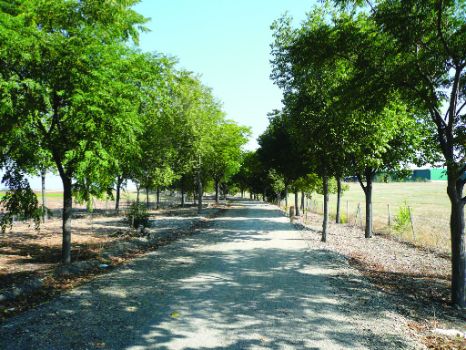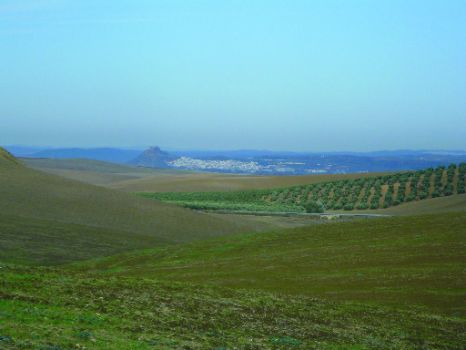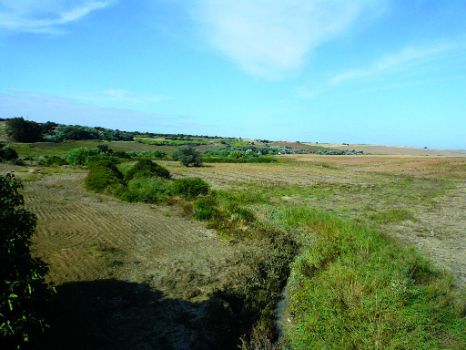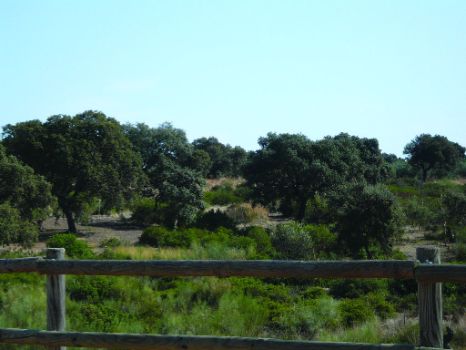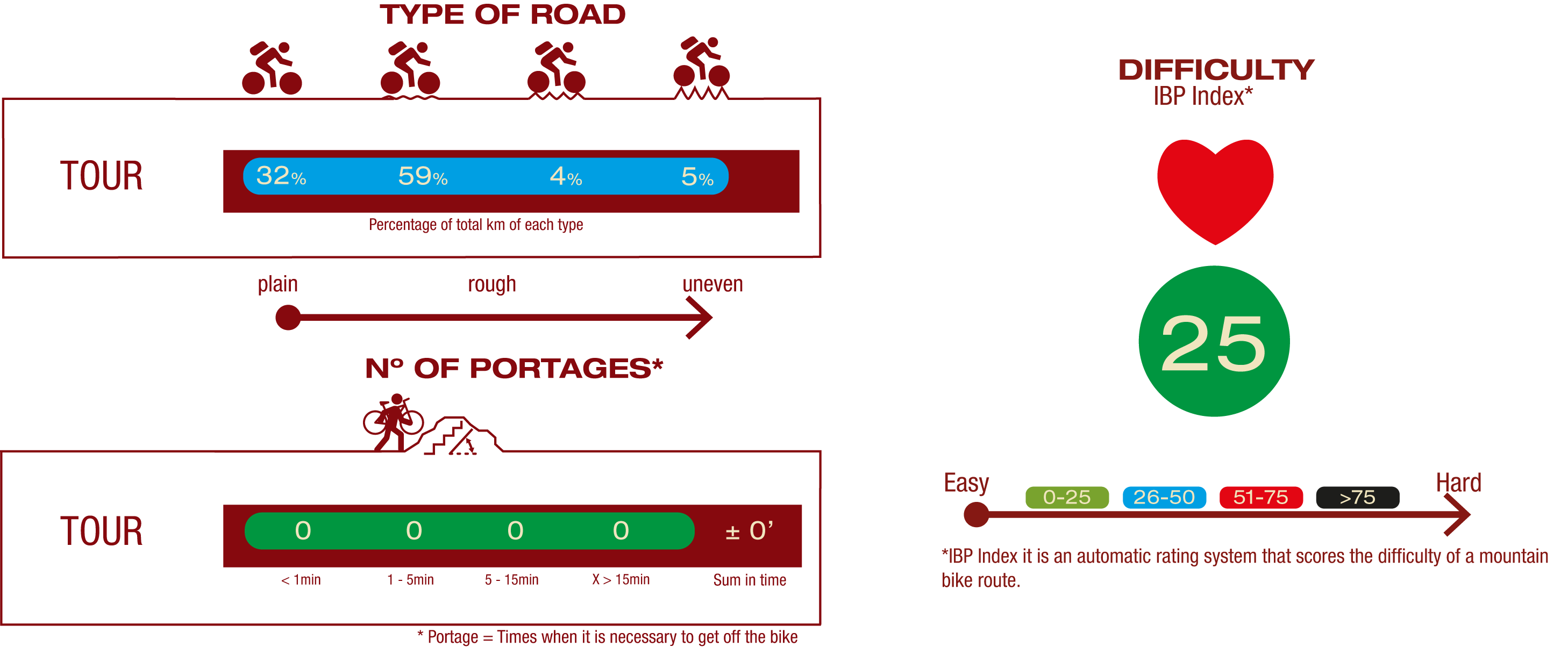Net of Natural
Trails

La Campiña Nature Trail
Description
Sun amidst olive groves
This route runs along part of the old Cordoba-Marchena railway line closed in the 1970s. It passes through olive groves, sunflower and cereal fields, which are particularly beautiful in spring when the different plots that carpet this flat landscape explode in a kaleidoscope of contrasting colours.
The Trail starts approximately 17 kilometres from Cordoba, next to a large silo at Valchillón, near the A-3051.

Shortly after it crosses the River Guadajoz, remarkably well-preserved, and a riparian poplar forest (Populus sp.). Further along the Trail, several embankments and reed patches (Arundo donax) surround the railway, providing much needed cool shade on hot days. A rabbit (Oryctolagus cuniculus) or a partridge (Alectoris rufa) may occasionally cross the road. Typical steppe birds like crested larks (Galerida cristata), wheatear (Oenanthe sp.), corn bunting (Miliaria calandra), and even a few Montagu's harriers (Circus pygargus) may also be found.
The town of Almodóvar del Río appears after passing through Las Tablas, the only tunnel on the route. To the left, on a hill overlooking the town and the surrounding area stands its castle, declared a Property of Cultural Interest open to visitors.
Further ahead, the Trail crosses Redondo Brook, and later on the Torvisca Bridge, with views of the town of Guadalcázar. The route continues to a rest area, where the former Guadalcázar station stood. The only place where drinking water is available is on the opposite side of the CO-3304.

Further on is Marota bridge, whence the landscape changes. The terrain allows pockets of Mediterranean vegetation typical of this area like holm oaks (Quercus ilex), large mastic trees (Pistacia lentiscus), myrtle (Myrtus communis) and other shrub species. An island of local primitive landscape in a sea of rolling countryside, where different mammals like the fox (Vulpes vulpes) or Egyptian mongoose (Herpestes ichneumon) find shelter.
The route reaches a fork in the Trail. The path to the right leads to a periurban park with tables, where it is possible to spend the day under the shade of kermes oaks. The pilgrims from Guadalcázar commemorate each year in this park, on May 15, the feast of Saint Isidore the Labourer.
The Trail continues through olive groves to Las Pinedas de La Carlota rest area, where two ancient fountain-cum-drinking trough and a farm school can be found. Shortly after, the road crosses Guadalmazán Brook and reaches the A-445, very close to La Fuencubierta, another hamlet of La Carlota. After crossing the road, the Trail continues approximately four kilometres along a country road and ventures into the province of Seville. Immediately after crossing the road, to the left, is the path to La Carlota station. This path crosses through private vegetable gardens, and further on, it passes under the Madrid-Seville high speed railway line (AVE).
The route continues to Navalagrulla station, now in ruins, but with a small rest area. A little further on, the Trail crosses the road to Palma del Rio.

From here onwards, the landscape is dominated by cereal crops, with pockets of cotton fields and olive groves. After crossing the A-8203, there is a rest area, next to the walkway over the A-453, with panoramic views of nearby Ecija, one of Andalusia's most important historic and artistic towns. It is advisable to make a stop and stroll around the old town, visiting some of its palaces, monasteries and churches. After the walkway, the Trail crosses a bridge leading into Ecija and becomes a bicycle lane. From here it continues straight along Avenida de la Estación, crossing a number of roundabouts, to a large silo, from where the route continues down Boabdil Street until it leaves the town.
Once again, a countryside landscape of cereals and sunflowers will accompany the route in this final stretch towards Villanueva del Rey, where the Trail ends at a rest area.
Managing Entities
Sites of interest
Puntos de interés
Hostel
Passport
Profile
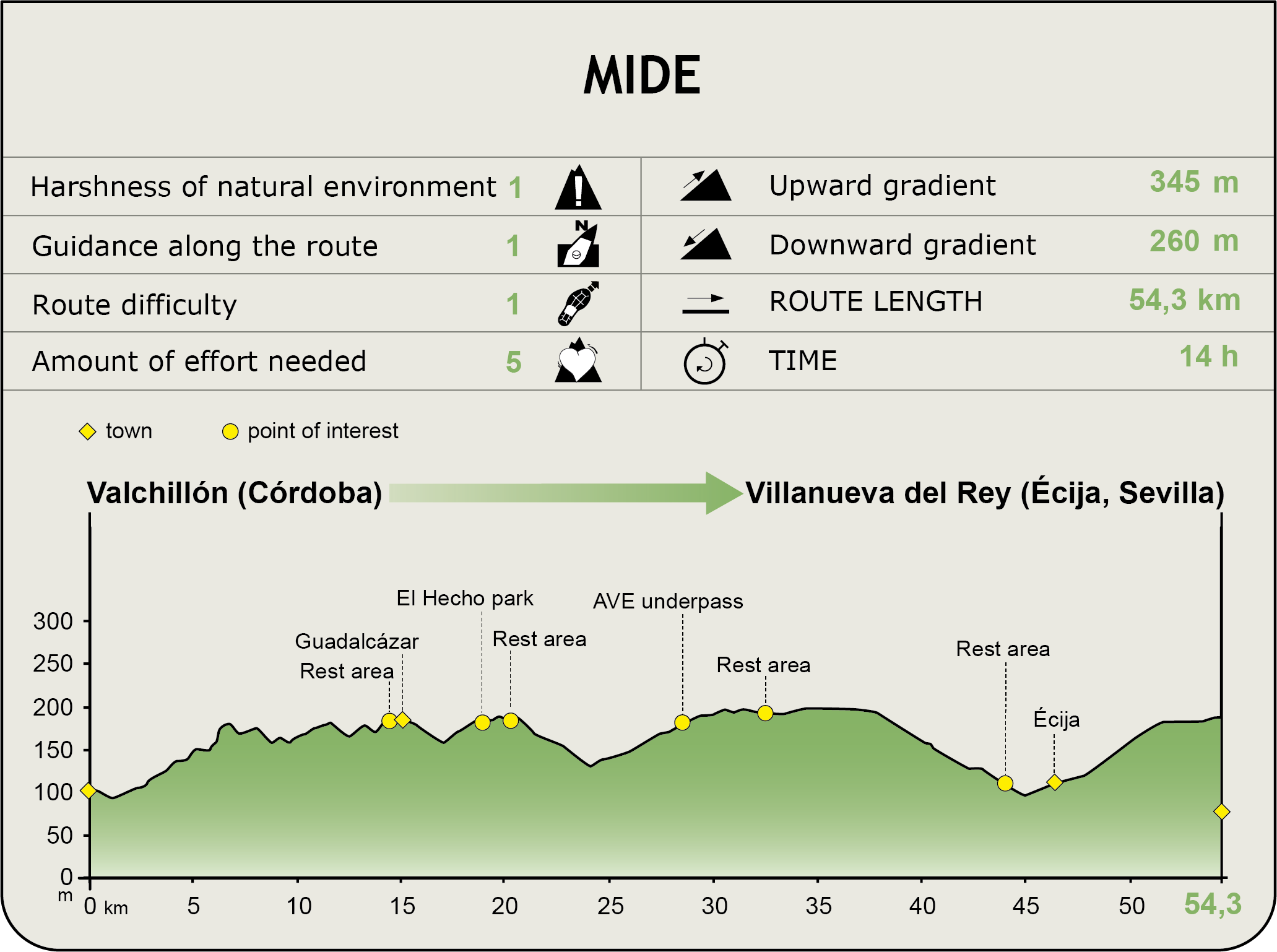
(Calculated according to the MIDE criteria for an average excursionist with a light load)
Highlights
Further information
The Importance of the Countryside
Steppe landscapes are characterised by wide open spaces without steep slopes, and a rich diversity of species adapted to the special environmental conditions, including birds like the crested lark or Eurasian skylark (Alauda arvensis), and other spectacular species like the little bustard (Tetrax tetrax), stone curlew (Burhinus oedicnemus) and sandgrouse (Pterocles sp.). Many of these species unique to Europe are endangered, mainly due to intensification of farming in the countryside.
Ecija: The City of the Sun or of Towers
Declared a Historical-Artistic Site, Ecija is also popularly known as the "City of the Sun" or the "City of Towers" since its skyline is graced by the eleven towers and nine belfries that crown its numerous temples. The old city centre, flush with palaces and belvederes, bears traces of Roman, Visigoth and Muslim settlements. Its designation as Historical-Artistic Site in 1996 has further established its reputation.
Multimedia
Downloads
GPS Downloads
Cyclability
TYPE OF ROADS, PORTAGES & DIFFICULTY
SAFETY RECOMMENDATIONS
- The route features several sections where the surface is overgrown with shrubs and herbaceous vegetation, often completely covering it, while in other cases only a narrow, clear path remains.
- There are also several sections shared with motor vehicles, exceeding one kilometer in length, particularly the one that runs along the railway ring road within the town of Écija.
- Special attention should be paid to road crossings.
- There is a straight tunnel without artificial lighting and numerous crossroads.
GENERAL RECOMMENDATIONS
- Find out about the technical aspects of the route and the weather on the day.
- Take care of the environment. Take care not to disturb animals or damage vegetation. Respect private areas.
- You must give priority to pedestrians and comply with general traffic rules.
- The environment in which you will be riding is open, free to move around and an area where many activities are carried out (sporting, forestry, livestock and agricultural activities).
- Always have an understanding, prudent, responsible and respectful attitude.



